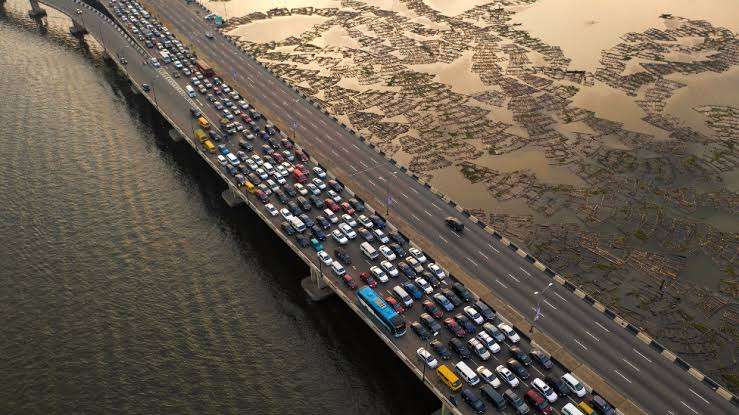As commuters move across Lagos’ Third Mainland Bridge, a powerful network keeps phone calls clear, internet speeds steady, and mobile services uninterrupted. At the heart of this infrastructure is a web of telecom engineering, designed to connect millions.
In a recent disclosure, Yahaya Ibrahim, Chief Technical Officer at MTN Nigeria, revealed that the company deployed a dedicated telecom network along the bridge to address persistent connectivity issues caused by congestion and distance.
“We have some sites that are providing coverage on the bridge,” Ibrahim said. “But because of the heavy traffic and the length of the bridge, we deployed a special solution in July 2025—a dedicated network designed just to cover the bridge.”
According to Ibrahim, the infrastructure, introduced in July 2025, includes distributed antenna systems (DAS) and fibre optic cabling installed along the bridge’s utility ducts.
Fibre Infrastructure Installed Above Ground
The Third Mainland Bridge connects Lagos Mainland to Lagos Island and carries between 117,000 and 133,000 vehicles daily, based on government traffic data.
Unlike typical urban deployments where fibre cables are buried underground, engineers working on the Third Mainland Bridge adopted above-ground installation techniques.
According to the company, fibre optic cables were laid through protective conduits: primarily fibreglass and high-density polyethylene (HDPE), which are resistant to corrosion and extreme temperatures.
“Right in the middle of the bridge, you’ll find all the electrical systems and fibre cables running through the utility ducts,” Ibrahim explains. “These cables provide power to the antennas and transmit data for the users on the move.”
According to him, to account for movement caused by heat, traffic vibrations, and environmental changes, the cables are fitted with flexible joints and loops to prevent damage to the fibre strands during structural expansion or contraction.
Minimising Signal Dropouts
According to MTN, the system enables continuous mobile handovers as commuters move along the bridge, allowing phones to switch between antennas without losing connection.
“Your phone is connected to a site, and as you move away, its signal weakens. The phone hands over to a new site as you get closer to it,” Ibrahim said.
“Sometimes, due to terrain, trees, or buildings, there could be a small coverage gap. But generally, in a place like Lagos, you won’t drive five or ten minutes without coverage.”
According to Ibrahim, water surfaces like the Lagos Lagoon can also refract radio signals, contributing to coverage inconsistencies. MTN says it adjusts antenna positioning and signal strength to reduce these effects.
Supporting Lagos’ Digital Growth
The upgraded infrastructure is part of MTN’s strategy to strengthen network performance. As Lagos’ population and data demand continue to rise, telecom operators are investing in more robust and location-specific solutions.
Lagos is home to over 17 million residents, with its population expected to surpass 25 million by 2030, according to demographic forecasts. This rapid urban growth has fuelled a corresponding surge in demand for mobile data and digital services across the city.
Nigeria, meanwhile, boasts more than 107 million internet users, making it one of the largest online populations in Africa. As the country’s commercial capital, Lagos contributes significantly to this figure, driven by its high population density, vibrant tech ecosystem, and a predominantly mobile-first user base.
To meet this escalating demand, telecom operators are investing heavily in infrastructure tailored to the city’s complex geography and population density.
A New Blueprint for Urban Telecom Infrastructure
According to industry analysts, the Third Mainland Bridge deployment is expected to serve as a model for similar infrastructure adaptations across other congested routes and public structures in Nigeria.
Telecom experts say such targeted deployments reflect a broader industry shift towards infrastructure integration in urban planning.
Funke Adeyemi, a senior telecom analyst, describes MTN’s initiative as a timely innovation for Nigeria’s congested urban corridors.
“The Third Mainland Bridge deployment demonstrates how telcos can think beyond traditional tower sites,” she told Techparley. “It’s a blueprint for how digital infrastructure can be embedded into public works, improving service quality where people need it most.”
For Aminu Issa, an Infrastructure Planning specialist, the approach signals a shift in how telecom services are being delivered in dense urban environments.
“Integrating network equipment directly into physical structures like bridges is a strategic move,” he said. “It allows for better coverage continuity, particularly in areas where traditional infrastructure is difficult to install or maintain. This is the future of urban connectivity.”
Infrastructure-Integrated Connectivity Across Africa
While MTN’s deployment on the Third Mainland Bridge is unique in its bridge-specific focus, similar infrastructure-integrated telecom initiatives are emerging across Africa.
Several countries are increasingly embedding fibre-optic networks into roads, railways, and power lines to expand digital access along major transport corridors.
In Ghana, for instance, CSquared has partnered with the national power utility, GRIDCo, to lease excess fibre capacity running along electricity transmission lines.
In North and Central Africa, large-scale projects like the Trans-Saharan Fibre-Optic Backbone and the Central African Backbone are also leveraging highway and railway alignments to install regional fibre infrastructure, linking cities and neighbouring countries with high-speed internet.
Industry leaders say such hybrid approaches could guide future deployments in congested African cities where traditional tower or underground solutions are no longer sufficient.
Talking Points
MTN’s deployment of dedicated telecom infrastructure along the Third Mainland Bridge is a bold response to the unique connectivity challenges of Lagos’ busiest corridor.
By embedding distributed antenna systems and fibre-optic cables directly into the bridge’s utility ducts, MTN is setting a precedent for infrastructure-integrated connectivity in urban planning.
At Techparley, we believe this is more than a network upgrade, it’s a signal of what’s possible when telecom meets engineering innovation in high-traffic environments.
The success of this initiative could inspire further partnerships between telcos, civil engineers, and city planners, paving the way for smarter, more connected infrastructure across Nigeria and beyond.
Looking ahead, scaling similar deployments to other congestion-prone sites like Carter Bridge, Eko Bridge, or even key intercity expressways, could turn these transit networks into backbones for digital access.
With demand for mobile services surging across Nigeria’s urban centres, MTN’s Third Mainland Bridge solution may just be the first chapter in a wider transformation of infrastructure-led connectivity.





